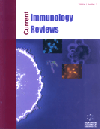- Home
- A-Z Publications
- Current Immunology Reviews (Discontinued)
- Previous Issues
- Volume 16, Issue 1, 2020
Current Immunology Reviews (Discontinued) - Volume 16, Issue 1, 2020
Volume 16, Issue 1, 2020
-
-
COVID-19: Update on Pathogenesis and Treatment Strategies
More LessAuthors: Rakesh K. Chauhan, Pramod K. Sharma and Shikha SrivastavaCOVID-19 (Coronavirus disease) is the most contagious virus, which has been characterized as a global pandemic by WHO. The pathological cycle of COVID-19 virus can be specified as RNAaemia, severe pneumonia, along with the Ground-glass opacity (GGO), and acute cardiac injury. The S protein of Coronavirus has been reported to be involved in the entry of the virus into the host cell, which can be accomplished by direct Read More
-
-
-
Can Mandated BCG Vaccine Promote herd Immunity against Novel Coronavirus? A Potential Solution at Hand to Tackle Covid-19 Pandemic
More LessThe 2019 novel coronavirus (2019-nCoV) infection is an emerging pandemic that poses a severe threat to global public health. This pandemic started from the Wuhan City of Hubei Province in China, and is speculated to have originated from bats and spread among humans with an unknown intermediate transmitter. The virus binds to angiotensin-converting enzyme 2 (ACE2), which is abundantly expressed on variou Read More
-
-
-
The Potential Prognostic Performance of Neutrophil CD64 and Monocyte HLA-DR in Patients with Complicated Intra-abdominal Infections
More LessAuthors: Evgeni Dimitrov, Krasimira Halacheva, Emil Enchev, Georgi Minkov and Yovcho YovtchevBackground: Complicated intra-abdominal infections are still associated with a high risk of an unfavorable outcome. Despite the equal treatment, the mortality rates in some patients’ populations remain significant, especially when the impaired immune response is present. Aim: The object of this research is to analyze the impact of pro-inflammatory neutrophil CD64 and anti-inflammatory monocyte HLA-DR on the final outco Read More
-
-
-
Is Immune Response Relevant in Interstitial Lung Disease?
More LessInterstitial lung disease, a term for a group of disorders, causes lung fibrosis, is mostly refractory to treatments and has a high death rate. After diagnosis the survival is up to 3 years but in some cases the patients live much longer. It involves a heterogenous group of lung diseases that exhibit progressive and irreversible destruction of the lung due to the formation of scars. This results in lung malfunction, disruption of g Read More
-
-
-
Immunomodulation in Multiple Sclerosis by Phytotherapy
More LessAuthors: Maryam Bahrami, Ghasem Mosayebi, Ali Ghazavi and Ali GanjiMultiple sclerosis is a chronic inflammatory and demyelinating disorder of the central nervous system (CNS) that can cause cognition, mobility, and sensory impairments. Studies have shown that the immune system through inflammation and autoreactive T cells are involved in the progression of MS. The present article aimed to review the potent anti-inflammatory, antioxidant, and immunomodulatory agents that could modula Read More
-
-
-
Interleukin-10 in Oral Lichen Planus - Review and Meta-Analysis
More LessAuthors: Farzaneh Agha-Hosseini, Nima Rezaei and Mahdieh-Sadat MoosaviBackground: Interleukin 10 (IL-10) is a powerful anti-inflammatory cytokine capable of preventing inflammatory and autoimmune diseases. Oral lichen planus (OLP) is an autoimmune, chronic, inflammatory disease with relapsing nature involving oral mucous membranes. It was prevsiouly assumed that like other autoimmune diseases, IL-10 may have a role in OLP pathogenesis, and many studies focused on that. But there Read More
-
-
-
Seroprevalence of Hepatitis B, Hepatitis C, and Human Immunodeficiency Viruses in End-Stage Renal Disease Patients, Southern Iran
More LessBackground: Hemodialysis [HD] patients are more prone to blood-borne viruses, such as hepatitis B virus [HBV], hepatitis C virus [HCV], and, to a lesser extent, Human Immunodeficiency Virus [HIV]. Chronic HBV and HCV infections are associated with liver cirrhosis, hepatocellular carcinoma, and early graft failure after kidney transplantation. As there was no recent information, this study aimed to evaluate the prevalence of Read More
-
-
-
Warm Reactive Anti-A1 Agglutinin in an A2B individual: A Rare Case with Review of Literature
More LessAuthors: Manish Raturi and Anuradha KusumThe prevalence of the major subgroup of A as A1 in almost 80% of the A group population is a known fact. A2 and the remaining subgroups such as Aend, Am, Ax etc comprise the remaining population, based on erythrocyte agglutinability and various serological reactions. These A subgroups can often result in an ABO typing discrepancy. Anti-A1 antibody often appears as an irregular cold agglutinin in the sera of A2 or A2B individu Read More
-
-
-
Thymosin α1; Potential Therapeutic Implications of an Immunoregulatory Drug in the Treatment of Lymphocytopenia Associated with COVID-19
More LessIt is not unbeknownst to us that since the very onset of the COVID-19 outbreak, many patients from different age groups have suffered greatly, and in a remarkable number of cases, succumbed to their untimely demise as a result of infection with the novel coronavirus or SARS-CoV- -2. The elderly are perhaps the most vulnerable community, who stand at the pinnacle of morbidity and mortality rates due to contracting sever Read More
-
-
-
Forecasting of COVID-19 Cases in India: A Predictive Study
More LessAuthors: Pooja Sharma, Tanu Sharma and Karan VeerAn outbreak of new coronavirus (COVID-19) originated by SARS-CoV has reached 212 countries throughout the world. India is the second-highest populated country, so it is critical to forecasting the confirmed cases and deaths due to pandemic. To fulfil the purpose, three machine learning models Linear Regression, Multilayer Perceptron, and Sequential Minimal Optimization Regression are used. The predictive data of three Read More
-
Most Read This Month
Article
content/journals/cir
Journal
10
5
false
en


